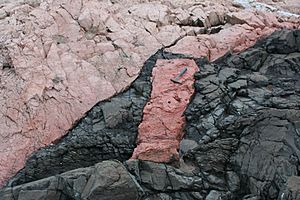Xenolith facts for kids
A xenolith is a piece of rock found inside another rock. The word "xenolith" means "foreign rock." Imagine a small stone getting stuck inside a bigger, different type of rock. That's a xenolith!
Xenoliths are most often found in igneous rock. Igneous rocks form when hot, melted rock (called magma or lava) cools down and hardens. When magma is flowing deep inside the Earth, or when lava flows on the surface, it can pick up pieces of other, older rocks. These pieces get surrounded by the cooling magma or lava.
Sometimes, instead of a whole rock piece, you might find a single foreign crystal inside an igneous rock. This is called a xenocryst. For example, you might find a quartz crystal in a type of lava that doesn't usually have quartz. Or, tiny diamonds found in a rock called kimberlite are also xenocrysts.
Even though we mostly talk about xenoliths in igneous rocks, they can also be found in sedimentary rock. These are rocks formed from layers of sand, mud, or other materials. Sometimes, even meteorites (rocks from space) can contain xenoliths!
Why Xenoliths Are Important
Xenoliths and xenocrysts are very useful for scientists. They give us clues about what's deep inside the Earth. The Earth's mantle is a thick layer of hot, solid rock beneath the crust. It's too deep for us to explore directly.
However, some types of magma, like those that form basalt or kimberlite, come from the upper mantle. As this magma travels to the surface, it can pick up pieces of the mantle rock. When these pieces, or xenoliths, are brought to the surface, scientists can study them. By looking at these "foreign rocks," we can learn about the minerals and conditions in the Earth's mantle, which we can't see otherwise.
Images for kids
-
Olivine weathering to iddingsite within a mantle xenolith
-
Xenoliths in granodiorite of the Alta Stock, Little Cottonwood Canyon, Utah
-
Rounded, yellow, weathered peridotite xenolith in a nephelinite lava flow at Kaiserstuhl, SW Germany
-
Xenolith in granite near Donner Pass, California (foot for scale).
See also
 In Spanish: Xenolito para niños
In Spanish: Xenolito para niños









